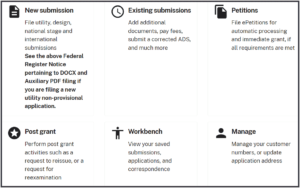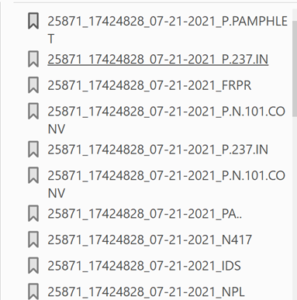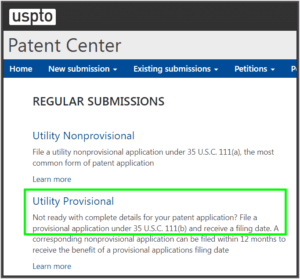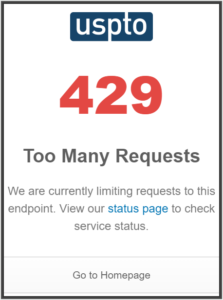The March 17 version of Patentcenter was clearly not tested before release. It breaks many things that worked properly in the pre-March 17 version. This has given rise to at least ten new trouble tickets in the Patentcenter Trouble Ticket page. Continue reading “March 17 version of Patentcenter breaks things that worked in previous version”
Pixel waste in content-free icons in the “modernized look and feel” Patentcenter

Today the USPTO rolled out its “modernized look and feel” version of Patentcenter. It contains lots of new content-free “icons” that take up valuable screen space, wasting pixels and forcing users to scroll further down to reach what they need. Continue reading “Pixel waste in content-free icons in the “modernized look and feel” Patentcenter”
A boundary-value programming mistake in Patentcenter

One of the easiest things to get wrong, for some programmers in some programming languages, are “boundary values”. Here we see a classic example of a boundary-value mistake by the developers of Patentcenter. Continue reading “A boundary-value programming mistake in Patentcenter”
Yet another Patencenter lapse – metadata failing to match Private PAIR

It is recalled that one of the requirements for Patentcenter is that it is supposed to replicate the functions of Private PAIR. Only after this replication is complete would USPTO be entitled to pull the plug on Private PAIR.
The latest lapse, reported by alert listserv member Jill Santuccio, is in the metadata that Patentcenter uses when providing a multi-document download from IFW. Continue reading “Yet another Patencenter lapse – metadata failing to match Private PAIR”
An upcoming USPTO meeting about Patentcenter
As some readers know, the USPTO plans eventually to pull the plug on EFS-Web and Private PAIR, leaving only Patentcenter as the way for USPTO customers to carry out the functions that have in the past been carried out in EFS-Web and Private PAIR. There are, however, many bugs in Patentcenter. And there are many features that ought to have been implemented in Patentcenter but have not yet been implemented. You can see some of the bugs and missing features listed here. These lists are the result of the hard work of the members of the Patentcenter listserv (learn how to join). Most of the items on the lists are by now more than two years old.
I am delighted to report that our listserv has managed to secure a meeting with Jamie Holcombe, the Chief Information Officer at the USPTO, to discuss some of the outstanding bugs and missing features. Continue reading “An upcoming USPTO meeting about Patentcenter”
A feature omission in Patentcenter – Track I fees
One of the expressly stated goals for the USPTO developers developing Patentcenter is that every feature and function of EFS-Web and Private PAIR be carried forward into Patentcenter. Only after this has been accomplished would it be acceptable for the USPTO to pull the plug on EFS-Web or Private PAIR. Unfortunately, users of Patentcenter frequently encounter situations where some feature of EFS-Web or Private PAIR has been only incompletely carried forward. This article describes a failure of the developers to fully carry forward all of the features of the Track I workflow. This harms applicants, as I will describe in some detail. Continue reading “A feature omission in Patentcenter – Track I fees”
USPTO harmed a Patentcenter screen

For four years now, the “applications” table in Patentcenter has had a standard column “attorney docket number”. There have been many things wrong with the USPTO’s default design of this “applications” table from the outset, as will be reviewed below. But one of the handful of things that the USPTO did not get wrong in its default design for the “applications” table was that it provided the attorney docket number. Imagine, then, the disappointment in the user community when, on January 16, 2023, the USPTO abruptly eliminated the “attorney docket number” column from the “applications” table. Continue reading “USPTO harmed a Patentcenter screen”
Monday morning: Patentcenter down for maintenance!
 USPTO made a wrong decision just now. Monday morning is absolutely the wrong time to take down Patentcenter for maintenance. Continue reading “Monday morning: Patentcenter down for maintenance!”
USPTO made a wrong decision just now. Monday morning is absolutely the wrong time to take down Patentcenter for maintenance. Continue reading “Monday morning: Patentcenter down for maintenance!”
Not ready with complete details for your patent application? file a provisional!
 I wonder if this language on the USPTO’s Patentcenter web site is bad legal advice? The e-filing system asks “Not ready with complete details for your patent application?” And the answer the USPTO gives is that if you are “not ready with complete details” then what you should file is a provisional patent application. Continue reading “Not ready with complete details for your patent application? file a provisional!”
I wonder if this language on the USPTO’s Patentcenter web site is bad legal advice? The e-filing system asks “Not ready with complete details for your patent application?” And the answer the USPTO gives is that if you are “not ready with complete details” then what you should file is a provisional patent application. Continue reading “Not ready with complete details for your patent application? file a provisional!”
Patentcenter and TEAS and PAIR and EFS-Web MyUSPTO and Financial Manager are all broken just now

(Update Monday July 11. The USPTO status page now admits that these systems are broken. “Users are intermittently receiving a 429 error code ‘too many requests’ when attempting to log into their USPTO.gov accounts to file in Patent Center, EFS-Web, TEAS and TEASi. The workarounds for this error are clearing the browser cache or switching web browsers. Other USPTO systems may also be affected. The USPTO technical teams are investigating.“)
It looks like Patentcenter and TEAS and PAIR and EFS-Web and MyUSPTO and Financial Manager are all broken just now.
The USPTO switched over to a new and different login system a couple of weeks ago, provided by a company called Okta. The way that you can see change this is that when you log in at any of the six above-mentioned USPTO systems, the throbber (Wikipedia article) looks very different from the way it used to look for the past decade or so. Now the throbber is a sort of hexagon made of blue dots, hovering over the words “signing in”, with corporate branding “Okta” in the lower right corner of the screen.
 At right you can see a screen shot of the USPTO’s newly adopted throbber screen, which as I say first started showing up maybe two weeks ago.
At right you can see a screen shot of the USPTO’s newly adopted throbber screen, which as I say first started showing up maybe two weeks ago.
For most of the past two weeks, the new Okta throbber screen seemed to work fine. But today (Saturday, July 9, around 10 AM Eastern Time) the throbber screen has been throbbing for maybe 45 seconds and then what pops up is the 429 screen that you see quoted at top right.
The practical consequence is that it is impossible to log in at Patentcenter or TEAS or PAIR or EFS-Web or MyUSPTO or Financial Manager.
When you get to the 429 screen, you see that “status page” is a link. I clicked on the link, and it brought me to a new page https://status.okta.com/ on which the Okta company uses lots of green check boxes to cheerfully explain that every one of their systems is operating normally.
The USPTO maintains what it misleadingly calls its USPTO Systems Status and Availability page. When some USPTO system does not seem to be working correctly, it is tempting to visit this page to see whether perhaps somebody at the USPTO has (a) noticed that the system is broken and (b) posted a message on this page to acknowledge that the system is broken. It is normally a complete waste of time to check this page, and today was no exception. Yes the page lists various scheduled maintenance activities that are set for today, but none of them involve any of the six systems mentioned in this blog article. And, predictably, the status page shows no indication that anybody at the USPTO has noticed that these five systems are broken just now.
Returning to the 429 screen quoted at top right, you can also see that “Go to Homepage” is also a link. I clicked on the link, and it brought me to a new page at the USPTO, inviting me to log in. I entered my user ID and clicked “next” and what popped up is a big red message “Unable to sign in”.
If you want to keep up to date on the status of the important USPTO systems, what is quite clear is that checking the USPTO Systems Status and Availability page is not the way to do it. The way to do it is to be a subscriber to the relevant listserv, for example the e-Trademarks listserv, the Patentcenter listserv, the PAIR listserv, and the EFS-Web listserv. Or, I suppose, to be a subscriber to my blog.
